Instead of our traditional LEGO Zombie Creation of the Week, I had the opportunity to sit down with one of my favorite LEGO® custom accessory makers, BrickWarriors, to learn about how they do what they do, learn about their history with LEGO®, and find out about their new book, Riddle of Regicide.
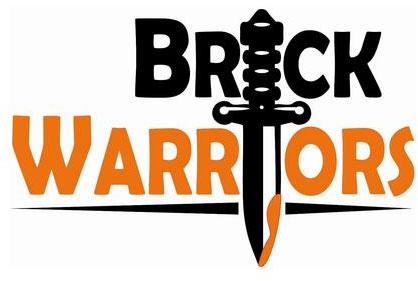
Bricks of the Dead: What is your strategy to set BrickWarriors apart from other custom accessory makers? Do you communicate at all with your competitors?
BrickWarriors: Our strategy is simple. We want to consistently provide the LEGO® community with new products to enhance their minifigures in ways that were not previously possible. That usually means releasing new designs at least once a month. We do not talk to our competitors often, but if we see them at a convention we’ll usually stop by to say hi and have a brief conversation.
When you’re coming up with new ideas, what is your focus? Do you want to solve design problems, open up new ways for people to tell stories with their play, just have fun?
My focus is on making the coolest pieces possible. There are thousands of accessories that I always wished LEGO® would make, so now I’m going through and trying to produce all those as quickly as possible. We also get lots of great suggestions from our fans. I don’t set out specifically to solve design problems, but a lot of times solving design problems is necessary for certain pieces. The ogre armor is a great example. I always wanted to have a two headed minifig, but I had no idea how it would work with the single head stud in the center of the torso. Then one day it came to me: give the armor big, bulky shoulders that are tall enough to cover the main stud, and then have two more sticking out the top of the armor.
You seem to primarily focus on weapons and armor, do you have any plans on producing accessories for building, like one of your competitors u-clips?
My top priority is making accessories that fit with minifigures, but I’m fine with them also working well for building. In fact, a lot of my products are already useful for building. The magic wand, for example, works well as the top of a bedpost (as seen in my Riddle of Regicide MOC!).
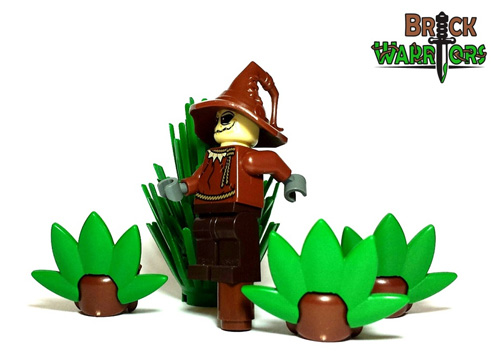
Have you had any communication with LEGO®? Any worries about them trying to stop you from producing your accessories?
I can’t speak for LEGO®, but my view is that at worst BrickWarriors has no effect on them, and at best maybe our accessories cause a few more people to get interested in LEGO® or stay interested in LEGO® for longer. If that’s the case, then I don’t see why they’d want to stop us!
What about parents or others concerned about the implied violence of your accessories? One of your competitors was hammered in a newspaper article a few years ago about this, although it never generated too much outcry.
I think that violence being such a newsworthy item is part of why I think that semi-violent toys aren’t a huge deal. The things shown on the nightly news are far worse than things a kid will likely come up with while playing with minifigures. Preventing kids from committing violent crimes isn’t about sheltering them from the existence of violence, it’s about making sure that they know violence is wrong and has very real consequences. I staged plenty of gladiator bouts between my LEGO® minifigures as a child, but that doesn’t mean I think that real gladiator fights should occur.
What goes into producing a new accessory?
A lot of time and money. First I come up with the idea and find a good reference image or images online. Then I design it in CAD and put it in a virtual minifig’s hand to see how it looks. If it looks bad, I make a few tweaks, and if it looks good, then I get a 3D print of it made. Sometimes it looks perfect in the 3D print, but if it doesn’t then I make a few more minor changes. In some extreme cases the 3D print just looks horrible, in which case I scrap the design completely. Then I send the design to my manufacturer to be cut into a mold. Once it’s finished, they send me some samples for me to critique. This continues until I think the piece is perfect. The final step, of course, is mass production.
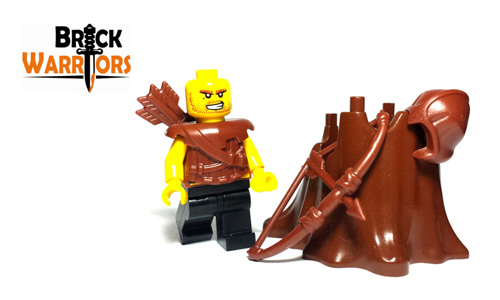
What has been your favorite accessory to date? Your most difficult? Has there been anything you want to make, but can’t yet?
My favorite accessory that we’ve released so far is probably the two headed ogre. I always wanted a two headed minifigure so I was so happy when I was finally able to figure out a way to do it. My most difficult accessory is a piece that hasn’t been released yet. It took over 8 frustrating hours to complete! I would like to get into doing more hair, but the CAD program I have doesn’t cooperate when I try to design a piece with so many organic curves. I’ve been experimenting with different ways to do it, but so far I’ve been unsuccessful.
Where do you go for inspiration?
I generally don’t have to seek out inspiration. There are so many different designs that I’ve wanted ever since I was a little kid, and then new ideas can always come out of video games, TVshows, movies, and books. If that isn’t enough, I always have a nice pile of suggestions from fans. If I’m really feeling uninspired then I can always look on Google Images for cool pictures of weapons or read articles on Wikipedia about various types of warfare.
How do you produce your accessories? Do you produce them in house, or send the designs to a fabricator?
They are injection molded in China. Our manufacturer does a great job of working with us to ensure that the pieces meet our quality specifications and fit perfectly with LEGO® minifigures.
How many people work at BrickWarriors? What’s your biggest challenge as a business?
We currently have four people working at BrickWarriors full time (including Amanda and I, the founders). It’s impossible to say what our biggest challenge has been…it seems like every day presents a new challenge! Due to the holidays our biggest challenge recently has been trying to meet our goal of shipping our all orders within 24 hours.
Where did you get the idea for Riddle of Regicide?
After seeing The Hobbit: An Unexpected Journey two years ago, I came home and was talking about the movie with Amanda and my mom. We all liked it, so one of us suggested that we have a competition to write fantasy novels and see who’s can sell the best. Two years later, Riddle of Regicide was a finished novel. Amanda’s novel, Curse of the Moira, is now available too. The third novel that was part of the challenge is still being edited.
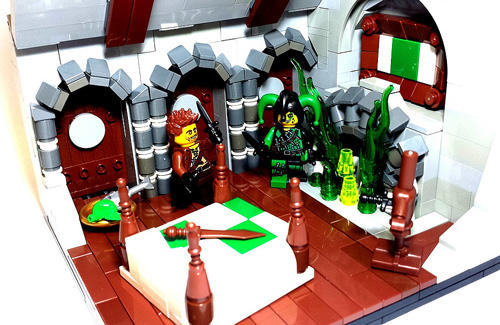
Have you always aspired to being a writer? Has fantasy been your default genre?
No, I never thought I would be a writer. As a kid I pretty much hated reading until I discovered that good books actually exist rather than the garbage I was forced to read in school. Even after discovering good books I still didn’t become an avid reader. Thrillers/Mysteries have always been my favorite genre of books, but fantasy has always been my favorite genre for video games and playing with LEGO®.
What inspired Riddle of Regicide, and how do BrickWarriors products factor in? Did the toys help you to flesh out your ideas?
So many different things inspired Riddle of Regicide. It’s impossible to list them all, but a few that come to mind are the classic RPGs Quest for Glory and Baldur’s Gate 2, awesome fantasy movies like Lord of the Rings and The Hobbit, and best-selling thrillers by Harlan Coben and David Baldacci. A lot of the characters in Riddle of Regicide are described as wearing or wielding BrickWarriors pieces (some of which will be released in 2015!). I also designed most of the major characters as minifigures and have been slowly releasing them as Limited Edition Minifigure on www.brickwarriors.com. Making the characters into minifigures definitely helped me flesh out the characters because it forced me to imagine exactly how they looked and what they were wearing.
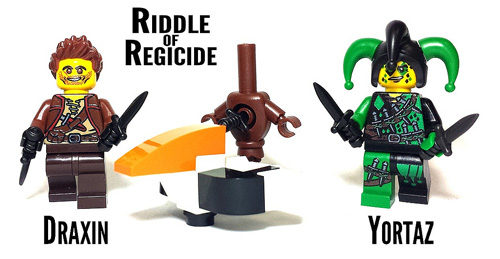
Tell me about your personal history with LEGO®.
My personal history with LEGO® goes back as far as I can remember. I’ve always loved building MOCs (although I didn’t realize they were called MOCs until I discovered Eurobricks in the early 2000s), but more-so I enjoyed putting minifigures together and making them interact with each other. I was often able to rope my brother, mom, and friends into playing games with me. They started off as just silly games where the characters would talk to each other, but as I got older we were basically using the minifigures and MOCs as part of a table-top RPG for which we had our own rule set. I always wanted to have cooler weapons and armor for my minifigures, but LEGO® would only release a few new designs each year. Once I realized it was possible to get my own designs injection molded, I immediately got a CAD program and taught myself how to design accessories.
You taught yourself CAD? Tell me about that.
Back in high school my mom bought me a CAD program as a Christmas present. I shoved it aside for a while in favor of putting together all the LEGO® sets that I also got for Christmas, but eventually I got around to playing with it. My first designs were awful but I got better with each item I designed. At some point I realized that the program wasn’t the best for what I was doing, so I downloaded a few samples of other CAD programs and found one that had all of the functions that I needed. I’ve been practicing with it ever since then and I feel like I learn new things about the program every time I do a design.
CAD and 3D printing has opened a lot of doors for you. As a LEGO® fan, I too always dreamed of making my own accessories like that. Do you see new technologies on the horizon that will open this up to even more people, or allow you to produce more complex accessories?
With current technology it’s pretty simple to design a piece and have it 3D printed, but the quality just isn’t there yet. Injection molded pieces are nice and smooth, while 3D printed pieces usually have a grainy texture with visible lines. I’m sure that the 3D printing technology printing will continue to improve, but I’m not sure when 3D printing will be better than injection molding on a large scale. A good analogy would be to compare it to the printing industry (since I’ve had to do a lot of research about that with BrickWarriors Publishing!): it’s easy to print a quality book with a digital inkjet printer, but on a large scale it’s still way cheaper to do a good old fashioned offset print run.
Regarding the complexity of pieces, it’s possible to create much more complex molds than the ones I use, but I enjoy the challenge of designing a piece for a simple mold that looks like it was made by something far more complex.
It seems like you’re really into gaming, especially role playing. Have you considered a set of role playing rules that could work with BrickWarriors accessories?
Definitely. I always used LEGO® minifigures for role playing games when I was younger, so making a set of rules that utilize BrickWarriors accessories is an obvious step to take. In fact, I have a bunch of spreadsheets floating around on my computer that put all of our items into different weapon and armor classes. I keep wanting to sit down and finish the rules, but it just hasn’t happened yet. Maybe that’s a project for 2015…
What advice would you give for people who might be interested in producing their own accessories?
I wouldn’t give them any advice since they’d be my competitor!
Great interview! I remember seeing the knife throwing MOC on TBB but I did not realize there was a full book behind it, quite an accomplishment!
I like the back story on the book too; just like Frankenstein.